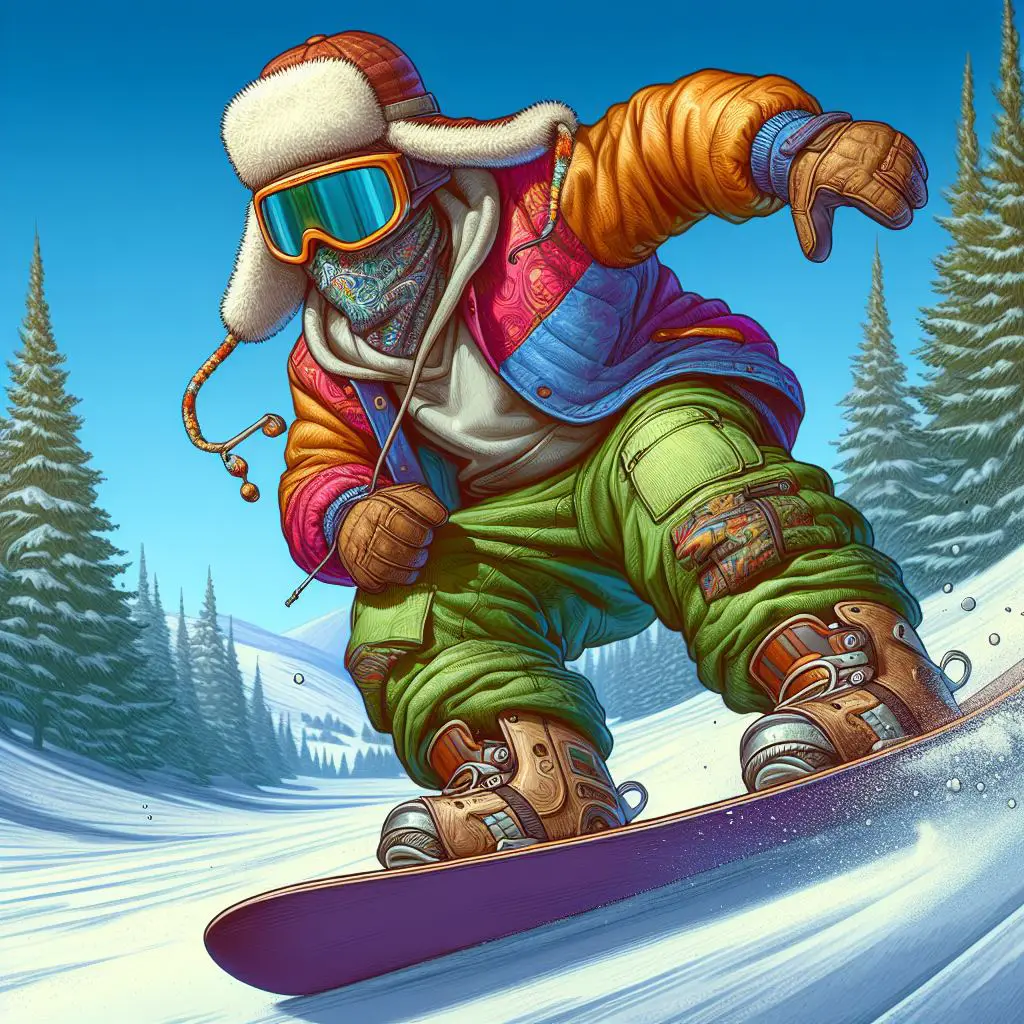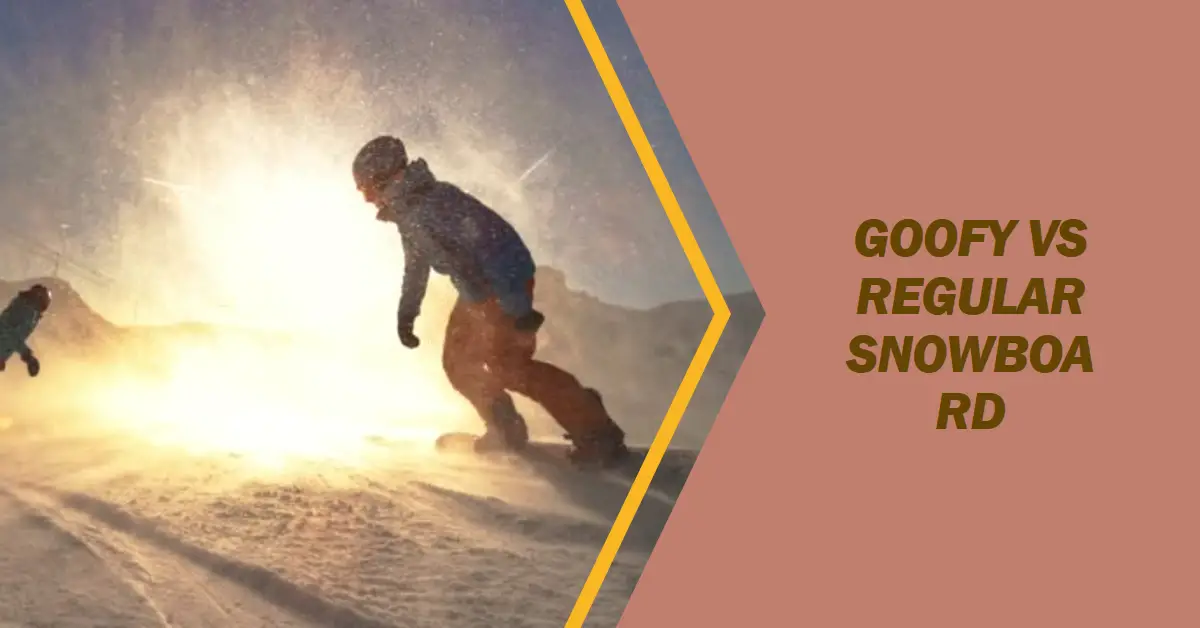One of the first things any new snowboarder learns is their stance – either goofy or regular. Your stance determines which foot goes in front and which trails behind while riding. But how do you know which stance fits you best?
This comprehensive guide examines the differences between goofy and regular snowboard stances. It covers the pros and cons of each stance, how to determine your natural stance, and techniques to ride in either stance. By understanding the nuances of goofy vs regular, you can develop the optimal snowboarding position tailored to your abilities.
Let’s dive into proper stance to help you carve down the mountain with confidence!
Table of Contents
What is Goofy vs Regular Stance?
Snowboard stance refers to the orientation of your feet on the board – which foot leads at the front, and which one trails behind.
In a goofy stance, your RIGHT foot is in the front position downhill. Your LEFT foot trails behind.
In a regular stance, your LEFT foot leads at the front, with your RIGHT foot at the back.
Determining Your Natural Stance
Your natural stance is whichever foot position feels most comfortable and balanced. But how do you determine if you are naturally goofy or regular?
Here are some common methods:
- Slide test – Imagine sliding along the floor on ice in socks. Whichever foot you put forward first is likely your natural lead foot.
- Kick test – Have someone hold a ball, and go to kick it instinctively without thinking. Your kicking foot will be your rear trailing foot typically.
- Board sport test – If you’ve tried other board sports like skateboarding, surfing, or wakeboarding, this can indicate your stance, as you’ll likely be comfortable sticking with the same one.
- Lead foot test – Your natural lead foot when walking down stairs or stepping off a curb is likely your front foot in a snowboard stance.
Spend time trying a goofy and regular stance on a snowboard to see which provides better balance and control. Don’t overthink it – your natural stance will become apparent.
Benefits of a Goofy Stance

Riding goofy (right foot forward) provides some key advantages:
- Better visibility – your dominant left eye is facing forward
- Stronger side in front – having your dominant hand/side leading gives better control
- Matching other sports – goofy matches skateboarding and surfing stances
- Better toe side – the rear foot typically has an easier time on toe side
- Wider stance – back foot can widen for balance and stability
Overall for many, a goofy stance feels intuitive and balanced when first learning. Keeping your dominant hand/eye forward provides better visibility and coordination. It also transfers well if you’re experienced in other board sports.
Challenges of a Goofy Stance
However, adopting a goofy stance isn’t always easy for everyone. Here are some common struggles:
- Feels unnatural – a regular stance may feel more comfortable
- Weaker heel side – heel side is controlled by your front leg
- Matching skiing – a regular stance parallels skiing position
- Pushing unfamiliar – pushing with the left foot instead of right can feel awkward
- Adaptive equipment – rental gear is often set up for regular by default
- Lesson difficulty – instructors may use regular stance in beginner lessons
Because many daily activities rely on the left foot forward, a goofy stance can feel unusual at first. It takes time to get used to controlling heel side turns and pushing with your weaker foot.
Benefits of a Regular Stance

For those who ride left foot forward (regular stance), advantages include:
- Feels natural – regular matches walking and most sports
- Heel side mastery – front foot has better heel side control
- Pushing power – stronger right foot forward for balance pushing
- Matching skiing – regular stance transfers skills from skiing
- Adaptive equipment – most rental boards default to regular stance
- Easier to learn – regular is common for beginner lessons
With your dominant left foot leading, a regular stance allows better control initiating heel side turns. Pushing with the rear right foot also mirrors skiing for those making the transition. Overall, regular provides a more intuitive starting point for many.
Challenges of a Regular Stance
Despite its versatility and ease for beginners, a regular stance also comes with difficulties including:
- Unnatural feel – less intuitive if used to goofy in other sports
- Visibility – head is rotated slightly downhill
- Weak toe side – rear foot controls toe side turns
- Carving – torso rotation to toe side can be awkward
- Fatigue – counter-rotated upper body can tire muscles
- Lesson transitions – relearning if instructed in goofy initially
The rear foot works harder controlling toe side carves and linked turns in a regular stance. Look ahead requires increased neck rotation. These factors, along with an unfamiliar feel coming from other sports, means mastering a regular position requires dedication for some.
Developing Your Stance
Whichever stance you start with, regular or goofy, here are tips to develop skills:
- Stick with one stance – consistency fosters muscle memory. Avoid switching back and forth.
- Equally practice both edges – work on toe side and heel side equally to prevent bad habits.
- Widen rear foot – widening your trailing foot slightly improves stability.
- Modulate upper body – consciously counter-rotate your shoulders and hips as you switch edges.
- Visualize the outcome – imagine completing turns smoothly before executing them.
- Ride switch – practicing riding “switch” with the opposite stance improves overall balance and coordination.
- Be patient – developing a truly natural feeling stance takes repetition over multiple days, weeks, and seasons. Stick with it!
Learning your optimal stance is a gradual progression. Remain open to trying both regular and goofy to determine what provides the best riding experience for you.
Tips for Riding Goofy
Here are some key pointers for mastering a goofy stance:
Starting and stopping:
- Push gently with your LEFT foot to start moving
- Keep your RIGHT foot strapped in to avoid catching edges
- Your LEFT foot dismounts at the lift and chairlifts
Edge control:
- Focus on your FRONT right foot to initiate heel side turns
- Rely on your REAR left foot for toe side carving
- Keep knees bent and centered over your edges
Imbalances:
- Shift your WEIGHT BACK slightly to avoid catching your heel edge
- Widen your REAR LEFT foot to improve stability
- Counter-rotate your UPPER BODY toward toe side
Deep powder:
- Lean BACK and keep rear foot ELEVATED to avoid drag
- Keep shoulders aligned with the board angle
- Use a narrower STANCE for quicker turns
Switch riding:
- Focus on smooth EDGE CONTROL with your unnatural foot forward
- Start on GREEN runs to build confidence switch riding
- Mimic your REGULAR STANCE moves and technique
Tips for Riding Regular
To excel riding regular stance:
Starting and stopping:
- Push gently with your RIGHT foot to get moving
- Keep your LEFT foot locked in to prevent edge catches
- Use your RIGHT foot when dismounting lifts
Edge control:
- Your FRONT left foot controls initiating heel side turns
- Use your REAR right foot to engage toe side carves
- Maintain low athletic stance centered over your edges
Imbalances:
- Distribute more WEIGHT OVER FRONT FOOT to avoid heel edge catches
- Widen your REAR RIGHT foot slightly for added balance
- Rotate your UPPER BODY toward heel side as you switch edges
Deep powder:
- Lean BACK while keeping your REAR FOOT ELEVATED to reduce drag
- Keep your SHOULDERS facing downhill as you turn
- Set your STANCE NARROWER for quicker turns
Switch riding:
- Slowly look over your SHOULDER to see uphill
- Focus on keeping EDGES FLAT when learning switch
- Start switch riding first on GREEN terrain you’re comfortable on
Why Goofy May Feel More Natural for Beginners
For those just starting out, riding goofy often initially feels more balanced and controlled. Some reasons why goofy can click right away for beginners:
- The front foot leads the board and controls initiation of turns. It’s advantageous to have your dominant side forward.
- Having your dominant eye facing downhill improves visibility as you learn to scan the terrain.
- Other board sports like skateboarding have similar goofy stances, allowing skills to transfer over.
- Falling backwards is more common as a beginner. Goofy stance puts your stronger side at the rear for catching falls.
- The rear foot can widen into a “duck stance” more easily, improving stability.
So while goofy isn’t necessarily “better”, these factors make it intuitive for many people during their first days on a snowboard.
Why Regular May Benefit Advanced Riders
As you progress beyond beginner and intermediate into advanced snowboarding, regular stance offers some perks:
- Your dominant foot controls heel side, enabling stronger carving and edge control.
- Your front knee can press more directly downhill, improving edge leverage and grip.
- Your body naturally faces slightly downhill as you look ahead, aligning with turn direction.
- Pushing uphill with your rear foot mirrors skiing, allowing skills to transfer between sports.
- Switch riding comes more naturally, as your regular position matches your everyday stance.
So at an advanced level, a natural regular stance exploits the power and coordination of your dominant side. Mastering this takes time but enables precise control.
Changing Your Stance as You Improve
It’s okay to change your stance as your skills improve! For example:
- Starting regular but transitioning to goofy once comfortable controlling turns with your rear foot. This allows keeping your dominant foot forward.
- Learning goofy initially but going regular to utilize your stronger heel side as skills progress.
- Riding centrally with a narrow duck stance when starting out. Then widening into a clear goofy or regular stance as you gain stability.
Don’t be afraid to tweak your stance occasionally. You may discover advantages from switching as your abilities evolve. Remain adaptable to find your ideal stance.
The Importance of Switch Riding
To become a well-rounded snowboarder, practicing riding “switch” (opposite of your natural stance) is highly beneficial:
- Keeps your body balanced and less injury-prone from overusing one side
- Builds coordination by forcing both sides to learn edge control
- Provides versatility to land tricks switch and ride terrain features in either direction
- Makes traversing a slope or navigating a flat cat-track easier
- Allows you to comfortably talk to people riding beside you on chairlifts
- Improves control if you ever need to unexpectedly ride switch
Don’t neglect switch training. Devote entire days to riding switch or practice for short periods whenever you go out. This ensures you don’t develop bad habits relying only on your natural stance.
How Stance Affects Balance
Stance significantly impacts your balance on a snowboard. Here are key considerations:
- Wider stances provide more stability for beginners
- Goofy allows rear foot to widen more easily into a duck stance
- Narrower stances create a nimbler, quicker feel ideal for advanced riders
- Regular stances encourage weighting the front foot more to avoid heel edge catches
- A centered stance focuses balance directly over the board
- Match stance width to terrain – wider for speed, narrower for tighter control in trees
- Proper flexion with knees bent and stacked over edges enhances stability
Experiment to optimize your stance width and weight distribution for ideal stability and control.
Rider Profile Examples
Here are some examples highlighting how riders may go through multiple stances as their skills progress:
Rider 1
- Skill level: Beginner
- Stance: Regular
- Why it works: Matches natural walking stance. Front foot control builds confidence initiating turns.
Rider 2
- Skill level: Intermediate
- Stance: Goofy
- Why it works: Switched to put stronger right foot at front after getting comfortable heel side. Wider rear stance feels balanced.
Rider 3
- Skill level: Advanced
- Stance: Regular
- Why it works: Transitioned back once able to utilize power of front left foot for carving. Narrow stance feels snappier.
Rider 4
- Skill level: Expert
- Stance: Regular duck stance
- Why it works: Precise board control. Front foot turned slightly positive angles quick edge changes.
There’s no single “correct” stance. Find what works for your unique abilities as they grow.
How to Convert Stance on Rental Boards
Most rental boards default to a regular 15/-15 degree duck stance. But don’t be afraid to ask to have it adjusted!
To convert to goofy:
- Remove rear binding and re-mount facing opposite direction
- Swap bindings side-to-side so right binding is at nose
- Adjust binding angles to 15/-15 or preferred goofy angles
Have a shop technician assist if unsure. This allows renting equipment matched to your goofy or regular stance.
Foot Placement for Different Snowboarding Disciplines
Stance width and angles vary across riding styles:
Freestyle
- Narrower stance for spinning/flipping
- Increased rear foot negative angle for stability
- Moderate angles like 15/-15 for balance
Freeriding
- Moderate width for all-mountain versatility
- Centered 15/15 or duck stance for flexing between edges
- Wider for stability at high speeds
Powder
- Wider stance to keep tips up and float better
- Increased front foot positive angle to prevent diving in deep snow
- Exaggerated duck stance helps keep weight centered
Alpine/Race
- Very narrow stance for quick turns
- Low angles like 9/0 or 12/-3 for maximizing edge leverage
- Aggressive forward lean over front foot
How Other Board Sports Influence Stance
Experience in similar board sports can make certain snowboarding stances feel familiar:
- Skateboard stance matches a snowboard regular stance
- Surfing regular foot (left foot forward) mirrors a goofy snowboard stance
- Wakeboarding typically uses a regular foot lead, paralleling snowboard regular
- Water skiing left foot forward corresponds to a regular snowboard stance
Conversely, skiing is the opposite – a matched ski/snowboard stance puts your dominant side rear.
Building on existing muscle memory from other sports can provide an advantage choosing your snowboard stance.
The Impact of Foot Dominance
Most people exhibit foot dominance favoring one side, which influences snowboard stance:
- Right foot dominant → Goofy stance
- Left foot dominant → Regular stance
But it’s not an absolute – some prefer front foot opposite their dominant foot:
- Right foot dominant → Regular stance
- Left foot dominant → Goofy stance
Let comfort and balance override foot dominance alone when picking your stance. Don’t force an unnatural stance against your instincts.
Do Women Tend to Prefer Regular or Goofy?
There’s no significant correlation between gender and snowboard stance preference. Both regular and goofy stances are common for male and female riders.
Some notable patterns:
- Women transitioning from skiing often initially mimic their ski stance and ride regular
- Stronger lower body strength among men allows starting goofy
- Women may be more likely to allow instructors to determine their stance
But differences in male vs female stance preference are minor. Choose based on individual balance, comfort, and athletic ability rather than gender norms. Both men and women excel riding either goofy or regular.
The Impact of Age on Stance
Younger riders may find a particular stance more intuitive and comfortable:
- Children under 10 may gravitate toward goofy, matching their natural standing position
- Teens may adopt regular to mirror skiing experience
- Older adults may lack flexibility for a goofy stance
But any age can adapt to either stance with practice. Let personal preference outweigh age-based assumptions. Trying both is key.
Common Myths and Misconceptions
There are some common misconceptions worth debunking:
- “Goofy is for righties, regular for lefties” – While this matches sometimes, plenty of people ride opposite their handedness. Don’t let it override comfort.
- “Once you learn, you can’t change” – Your stance WILL gradually adjust and evolve to find optimal positioning as skills develop.
- “Regular is better” – Regional culture may favor regular, but both are equally valid. Choose what feels balanced.
- “50% of people are goofy” – Regular stance may be more frequent among general population. But among experienced snowboarders, goofy or regular are likely close to 50/50 split.
- “Goofy is just wrong” – Riding right foot forward is not wrong, simply less common in some areas.
How to Ride Effectively in Either Stance
The best option is to become competent riding both regular AND goofy. Here are tips:
- Spend entire days focused only on your non-dominant stance to develop skills.
- Focus on smooth edge control and letting your knees flow naturally over each edge.
- Visualize making clean carved turns before initiating them. Imagine where your weight will shift.
- Pick slopes you know well to avoid surprises. Build confidence on green runs before trying black diamonds switch.
- Widen your stance slightly for more balance until the unfamiliar stance feels more secure.
- Don’t resist the board’s rotation. Let it flow underneath you smoothly.
In summary, favor clear, conversational instruction supplemented by code snippets rather than dense code alone. Visual aids, summaries and FAQs can further boost comprehension. Straightforward writing enhanced by strategic code examples will maximize educational value for coding students. Let me know if you need any clarification or have additional guidelines!
